Known as quick-connect, push-on or push-fit, these breakthrough plumbing products are often at the center of plucky online debates. Since entering the U.S. plumbing market in 2004, the design and technology of push-to-connect fittings have revolutionized the industry as a quick, reliable, tool-free solution for connecting small potable water pipes. Driven by feedback from plumbers Read more
Plumbing

Known as quick-connect, push-on or push-fit, these breakthrough plumbing products are often at the center of plucky online debates. Since entering the U.S. plumbing market in 2004, the design and technology of push-to-connect fittings have revolutionized the industry as a quick, reliable, tool-free solution for connecting small potable water pipes. Driven by feedback from plumbers, this product class has evolved robust designs made of materials like rubber, silicon, brass and stainless steel, incorporating key components such as o-ring seals and gripping mechanisms.
But are they best used only as a temporary fix as some users claim, or can you count on them for a variety of long-term uses? We let the facts flow freely so you can make an informed decision on whether to give these fittings a try.

Rapid Adoption and Evolution
Two decades of innovation have made push-to-connect fittings indispensable for applications ranging from residential plumbing to advanced manufacturing. The most common uses are in residential service and repair, including some new builds. They went through a lead-free transition to newer models that are stronger and more durable, accelerating adoption further.
The American-made SharkBite Max model sets the industry standard with a stainless-steel retainer around the outside and a pressure rating of 250 psi. This doubled the burst pressure limit of the original model, the most popular push-to-connect fitting. A deeper insertion depth allows the new model’s steel teeth to engage the pipe more effectively, creating a stronger connection that eliminates the need for an interior tube liner.
Primary Benefits and Advantages of Push-to-Connect Fittings
Using push-on fittings means shorter installation times, fewer errors to correct, and easy, versatile disconnections and reconfigurations. No soldering, crimping, glue or special tools are needed for installation. Unlike conventional approaches, the pipe doesn’t need to be dry before making a connection. Water can be pouring out of a pipe and these fittings can still be quickly connected without a tool, even in a tight space, making them an excellent option for pipe repairs.
Knowing leaks and pipe aging are inevitable, it’s a good practice to keep some push-fit fittings handy. If it’s a failed joint pinhole leak, a push-to-connect fitting can be a fast, reliable and inexpensive solution, especially in areas where pipes are prone to freezing and bursting.
Other strengths of today’s push-fit models include:
- Perfect for transitioning between pipe materials, including copper, PVC, PEX, CPVC, PE-RT and HDPE (SDR-9)
- Fitting rotates around the pipe even after it’s connected
- Strong manufacturer warranties (SharkBite Max warranty is 25 years)
- Code approved to be buried underground (when wrapped in silicone tape) or installed behind walls
- Compliant with all regulatory changes
The simplicity and efficiency of push fittings have streamlined a handful of core plumbing tasks and even helped address labor shortages by making it easier to get new plumbers out in the field performing repairs quickly. They’ve also made basic and emergency plumbing repairs accessible to DIYers. However, despite their versatility, they’re not ideal for every situation.

Drawbacks, Limitations and Criticisms
Push fittings must be used in the right way to capitalize on their advantages. In the rare case when there’s a problem, installing them improperly or in a spot they’re not designed for is almost always the cause. By keeping a few points in mind, you can make the right decision every time on when and where to use them.
Here are the main things to consider for a smooth experience:
Initial Cost: The best push-to-connect fittings can be a bit pricier than soldering or crimping. You’ll save big on labor installing them faster, but the upfront cost per fitting can be higher.
Compatibility Limits: While leading push-fit fittings are compatible with almost all pipe types, they don’t work with everything, like galvanized steel or flexible hoses. And they still require specific fittings for certain transitions, like polybutylene to CTS tubing. This adds a step to some jobs and possibly to inventory management.
Not for All Applications: Standard push fittings are certified for potable water and radiant heating installations, limiting their use in industrial plumbing. Exceeding the certified limits (250 psi and 200°F for Max fittings) can lead to failures, so they’re not suitable for all high-pressure or high-temperature applications.
Designed for Single Use: While push-to-connect fittings can be removed if you need to adjust or test, they’re not designed to be reused multiple times in permanent installations. The integrity of the seal may be compromised with repeated removal and reinsertion.
Spotting Leaks: All push-to-connect fittings rely on o-rings for sealing. If the fitting isn’t installed correctly — such as failing to deburr the pipe — or gets jarred out of place inadvertently, the o-ring can get damaged, potentially leading to leaks. Although rare, leaks inside the fitting can be tougher to spot, so they might not be noticed immediately.
You’re best off choosing manufacturers that are transparent about the materials they use in their fittings, especially the o-rings since they keep the seal. For example, SharkBite Max o-rings are made of a specific type of rubber called EPDM (Ethylene Propylene Diene Monomer), chosen for its durability, flexibility and chemical resistance:
- EPDM is known for its resistance to aging and degradation, making it suitable for long-term plumbing applications
- It maintains its flexibility even at lower temperatures, ensuring a good seal
- EPDM is specifically selected for its resistance to chloramine, a disinfectant chemical often added to municipal water
Of these concerns, leaks are the most hotly debated. Some professionals still hesitate to use push-to-connect fittings behind walls because of concerns about long-term reliability and potential hidden leaks. But after two decades of continuous improvement and in-wall use by plumbers in homes and other buildings across America, these isolated instances can always be traced back to user error. Common causes of fitting failure include:
- Pipe that is unevenly cut, not deburred or not free of debris, potentially preventing a secure seal
- Using the wrong fitting for the wrong application
- Not marking the insertion depth to ensure that you pushed the pipe all the way into the fitting
- Not wrapping fittings in silicone tape that protects it from soil contaminants
- Rough or repeated disconnection
When it comes to quality, the widespread adoption of push-to-connect fittings speaks for itself. But don’t take anyone’s word for it. Test them out for yourself and you’ll see why they’ve become so popular with pros everywhere.

Plumbers Shape the Evolution of Push-to-Connect Technology
You can play a role in shaping this product’s evolution by sharing your thoughts and experiences directly with manufacturers. The best way to help drive the evolution of plumbing technology is for plumbers of all skill levels to share and connect online—post product reviews and reach out with comments and questions on social media or through company websites. Equipment manufacturers can serve you best when they hear from you often, and the most innovative tend to be more responsive to feedback.
Some manufacturers have employees who will share free resources like training materials and demonstrations to help plumbers integrate their game-changing products. If you ask nicely, they might even send someone to walk the job site with you when they can. Dropping the company a line on your favorite social channel is a great way to make another connection that’s built to last.
Written by Matt Glenn, senior product manager at RWC, a market leader and manufacturer of water control systems and plumbing solutions for residential, commercial and industrial applications.
Working as a plumber comes with all sorts of different safety warnings and precautions. Keeping your health and wellbeing as the number one priority whilst you’re working on any sort of job. Whether you’re new to the industry, or you’re an old hand there are a number of plumbing safety strategies you should always try Read more
Working as a plumber comes with all sorts of different safety warnings and precautions. Keeping your health and wellbeing as the number one priority whilst you’re working on any sort of job. Whether you’re new to the industry, or you’re an old hand there are a number of plumbing safety strategies you should always try to live by. Following some of these best practices will not only help you to take care of yourself, but it will also protect others around you too.
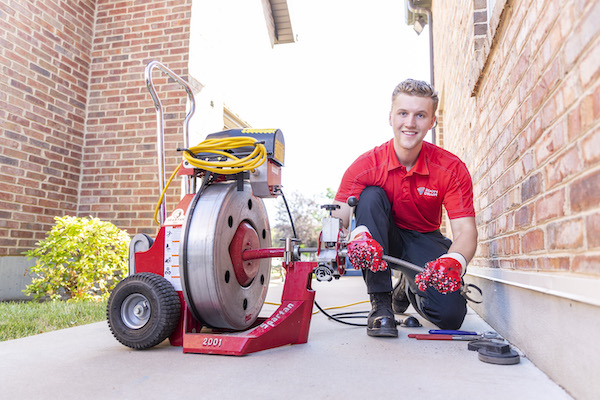
Protect Yourself
Protective gear as a plumber is always a must, no matter how big or small the job may be. Using personal protective equipment is the only way to ensure your working environment is safe and you’re protected from potential harm too. Wearing heat protection gear may also be a good idea if you’re carrying out lengthy jobs outside in the summer heat. It’s not always the direct job at hand that you need to be wary of, but also the natural elements outdoors too!
Protect Others Around You
It goes without saying that you always need to be wary of your surroundings when you’re undertaking any sort of job. Making sure that others are protected and safe from harm should always be a priority. With this in mind, you should always make sure that members of the public are out of the way whenever you’re carrying out a job in a domestic or commercial space.
Ventilate The Area
Ventilation is key whenever you’re working with materials that could pose a hazard to those in close proximity. Creating some airflow will help toxicity and dangerous fumes to escape so that you aren’t in any danger. Open up the windows if you’re in a building or invest in an exhaust fan to extract any toxic fumes that are produced.
Be Wary of Hazardous Substances
As mentioned earlier, there are plenty of times during your plumbing career, when you will need to use hazardous substances in order to get the job done efficiently. There are certain drain unblockers and chemicals that can pose a serious risk to your health and the environment around you if the proper precautions aren’t taken.
Look After Your Equipment
As a professional plumber, it’s your job to make sure all of your tools and equipment are well maintained and looked after. Ensuring everything is in good working condition will keep you and others safe.
Brush Up on Your Knowledge
When working in any trade, it’s so important to stay on top of health and safety guidelines and take regular training courses to enhance your knowledge when possible. You should always follow best practices for the plumbing industry and adhere to rigorous health and safety standards. This will not only make you a better and more knowledgeable plumber, but it will also help to keep you safe too.
Hopefully, these six ideas will help you to stay focused on the most important health and safety guidelines of being a plumber. From keeping up with your training, to staying protected with the right gear at all times, you will always be living by best practices and maintaining a good reputation as a professional plumber.

There’s a number out there that is pretty remarkable: 65% of construction workers that took their own life sought some sort of medical help within one month prior to the event. As we near the end of Men’s Mental Health Month—recognized every year in the month of June—suicide rates among construction workers are at an Read more
There’s a number out there that is pretty remarkable: 65% of construction workers that took their own life sought some sort of medical help within one month prior to the event.
As we near the end of Men’s Mental Health Month—recognized every year in the month of June—suicide rates among construction workers are at an alarming level. According to the Center for Disease Control (CDC), an estimated 6,000 construction workers died by suicide in 2022. In fact, the CDC found that men working in construction have one of the highest suicide rates by population: their rate of suicide is about four times higher than the general population and is the second-highest rate of all workplace industries at 45 per 100,000.
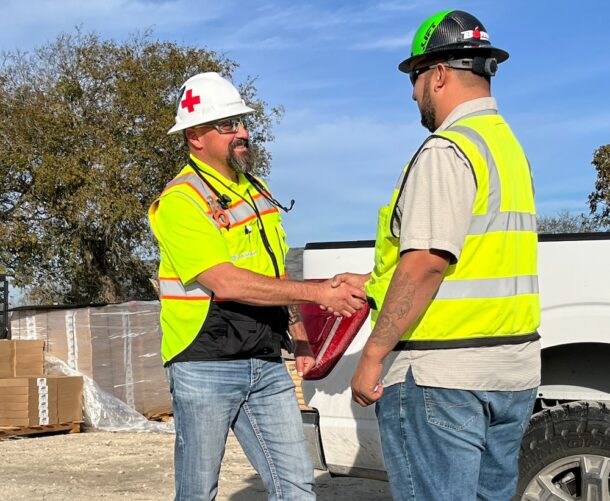
But why is the suicide rate so much higher in construction than other professions? Fact is, construction is an at-risk population for suicide. “Construction is a perfect storm for a predisposition for depression and suicide,” says Dr. Dan Carlin, MD, Founder and CEO of World Clinic / JobSiteCare, a resource to create safe workplaces and deliver great healthcare on the job.
Mental health is no different than, say, heart disease or diabetes. It is a dissolution of brain tissue. “If you are thinking of killing yourself, your brain is not working in a healthy manner,” says Carlin.
Crescendos and Dislocations
So, throw it back to that stat thrown out at the beginning of this article: Is there any relevance to that, you ask? Well, yes. A connection can be made between injury and suicide. Construction jobs in general can be tough on the body, and for those injuries that happened as a direct result of the work, individuals tend to self-medicate for the chronic pain. And, that can come in the form of prescribed drugs, illicit drugs (opiates, for example) and alcohol. But as the medication wears off, withdrawal sets in and the brain becomes vulnerable, with bad feelings magnified.
“Self-reliance and stoicism form a unique crescendo,” says Carlin. And men, more than women, fall into these characteristics. Especially in a male-dominated industry such as construction, the psychosocial aspect sees men focusing on things, whereas women tend to concentrate on people. Men are programmed to just shake things off in the face of adversity; address challenges in a more stoic nature. “Women are much more aware with other people than men.” says Carlin. “Men normally don’t look to others to talk. Men are more mission-focused—get the job done, on time.”
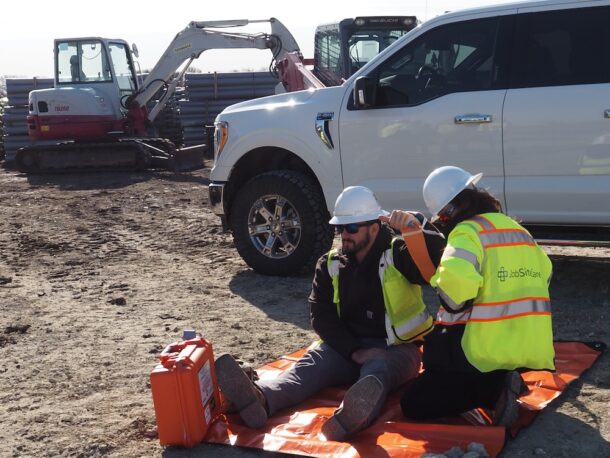
Often is the case in construction, one works long, rigorous hours, and often times away from family for long stretches of time. New projects arise and those old jobs come to an end—or one leaves one job for another that pays 20% more but loses that support network, which creates physical dislocations, says Carlin, and that usual social network goes away, resulting in less contact with family. Because the work dynamic has changed, this can lead to a dislocation to the family network, which can lead to friction and a sense of heightened vulnerability.
And let’s not forget COVID. “COVID was a tremendous paradox that has driven a lot of this due to social isolation, leading to depression and anxiety,” says Carlin.
Social Acceptance
Are we at a place in time where men in particular are more comfortable talking about mental health? It’s getting to a level of acceptance. “We’ve made a lot of progress but we aren’t all the way there yet. It’s not a sign of weakness. We need to be strong to share enough and aware enough to ask,” says Carlin.
Thomas Young, TY Custom Builders and Motherflushers Plumbing, agrees, saying, “I definitely think it’s more acceptable to talk about it. I think the people that are open about their issues or some of the people that are probably the ones that are dealing with it more than anybody. It shouldn’t be ‘hey, I’m an adult or I’m a man and I’m gonna deal with this on my own.’”
Easier said than done, some of the ways to reduce stress and damaging brain tissue is to cut back, be it work hours or substance abuse. Steps to increase brain health include exercise—which helps relieve stress, burning off anxiety—eating well and having a rhythmic day.
“When I’m overworked/stressed, I will just unplug, perhaps binge watch a show, and reach out to someone that helps bring peace,” says Young.
And that reaching out could include social media. “Social media has helped me create great friends,” says Young. “I have friends that live in different countries and will reach out, which can mean a lot.”
But, as we all know, social media, while supportive in so many ways, can have its negative rabbit holes. “With hateful comments and bullying, it was something that bothered me a lot in the beginning and I’d delete right away, but most the time,” says Young, “I can laugh it off or even engage back and it can help engagement.”
There is no one-size-fits-all solution to this. According to Carlin, “The nature of the cure starts at a community level where we need the confidence to ask, ‘how are you doing?’” Carlin says it’s important to establish relationships, and find an opportunity to talk about mental health when the time is right. “We can all learn to be a better listener and share stories about problems we all have as a community. We need to come to an awareness that the solution is us,” says Carlin.

For tradespeople, success hinges not just on technical expertise but on the quality of their relationships with clients. In a market where skills are often on par across the board, delivering exceptional customer service can set a tradesperson apart from the competition. Not only can excellent service enhance client satisfaction, but also it can foster Read more
For tradespeople, success hinges not just on technical expertise but on the quality of their relationships with clients. In a market where skills are often on par across the board, delivering exceptional customer service can set a tradesperson apart from the competition. Not only can excellent service enhance client satisfaction, but also it can foster repeat business and build a stellar reputation, all of which are essential for sustained success.
Below, we’ll go over seven tips for enhancing customer service and promoting stronger relationships in the trades.
-
Provide Clear Communication
First and foremost, being clear and communicative is crucial in the trades industry, where the specifics of the work might not be easily understood. Effective communication involves keeping clients well informed about job details, timelines, possible disruptions and progress. The better communication, the fewer misunderstandings and dissatisfaction. By making sure clients are consistently updated and feel listened to, tradespeople lay a foundation of trust and respect, which is indispensable for maintaining long-lasting business relationships.
-
Manage Expectations
Transparency from the start is key to building relationships as well. Tradespeople should be open with clients about what can realistically be accomplished given the available resources and time. Discussing limitations and setting clear, achievable goals right from the first meeting helps prevent client frustration with the final outcome. This approach also builds trust and minimizes the risk of negative feedback, thereby safeguarding the tradesperson’s reputation.
-
Exceed Client Needs
“Wowing” clients involves going beyond the basic requirements to provide service that adds real value to their lives. Whether it’s accommodating a client’s schedule or providing additional maintenance tips after the job is done, these actions enhance client satisfaction and loyalty, increasing the likelihood of repeat business and recommendations. For example, in sewer repair, a tradesperson might offer a complimentary follow-up inspection to confirm everything is functioning correctly and there are no further concerns. This approach makes the customer feel well cared for and valued.

-
Provide Proactive Problem-Solving
Generally, this relationship-building strategy requires anticipating potential issues and addressing them before they become problematic. This might mean advising on future risks to a plumbing or electrical system and how to avoid them. Showing foresight in this manner demonstrates that the provider is invested, not just in the immediate job but also in the client’s long-term welfare. This approach works to solidify a tradesperson’s reputation as thoughtful and reliable, encouraging clients to develop a lasting professional relationship.
-
Personalize the Client Experience
Making the whole process feel made to order can make a world of difference. This approach entails showing respect as well as a thorough understanding of individual client needs and preferences. It goes beyond remembering names; it’s about adapting communication styles, integrating personal preferences and showing genuine interest and respect for their space and time. Personalized service makes clients feel uniquely valued and cared for, significantly enhancing their overall experience and satisfaction.
-
Offer Flexible Solutions
Being able to accommodate different budgets and needs demonstrates a tradesperson’s adaptability and commitment to client satisfaction. By tailoring solutions to individual circumstances, tradespeople build stronger relationships and enhance their reputation as considerate and client-focused professionals. This flexibility can significantly increase client trust and encourage long-term loyalty.
-
Follow Up Consistently
Regular check-ins with clients after the completion of a job help confirm they remain satisfied. This is not just to address potential issues but also to offer continued support and advice. Such follow-up can transform a one-time job into an ongoing service relationship, providing tradespeople with a steady stream of loyal customers.
Cementing Success Through Service Excellence
Strong client relationships are the backbone of a thriving trade business. Putting these tactics into practice helps guarantee that clients are not only satisfied but also delighted with the service they receive. This in turn builds a better relationship and even encourages positive referrals.
Put simply, by prioritizing top-notch customer service today, tradespeople are investing in a prosperous and reputable tomorrow.
 Kareem Haddad is the owner of Absolute Rooter & Plumbing, a family-owned and operated company that has been improving the plumbing systems of Orange County and surrounding areas since 2010.
Kareem Haddad is the owner of Absolute Rooter & Plumbing, a family-owned and operated company that has been improving the plumbing systems of Orange County and surrounding areas since 2010.

Mechanical Hub recently caught up with the HammerHead Trenchless team at its St. Louis stop on the HammerHead Road Tour 2024. There, around 35 contractors took in this “lunch and learn”-type setting to get more acquainted with HammerHead product and service offerings. Right from the jump, there was a high priority on safety. “Safety is Read more
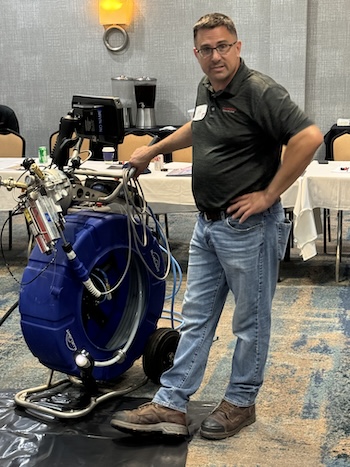
The St. Louis Road Tour host, Jeff Urbanski.
Mechanical Hub recently caught up with the HammerHead Trenchless team at its St. Louis stop on the HammerHead Road Tour 2024. There, around 35 contractors took in this “lunch and learn”-type setting to get more acquainted with HammerHead product and service offerings. Right from the jump, there was a high priority on safety. “Safety is the foundation of everything we do,” says Jeff Urbanski, senior manager, training and marketing with HammerHead—and our trenchless professor for the day.
Of interest to the Mechanical Hub team were the three live demos—assisted by Thomas Davies, application specialist—which started with CIPP point repairs, which included the point repair process with a standard packer wrapped in fiberglass coated in resin inserted into a PVC DWV pipe.
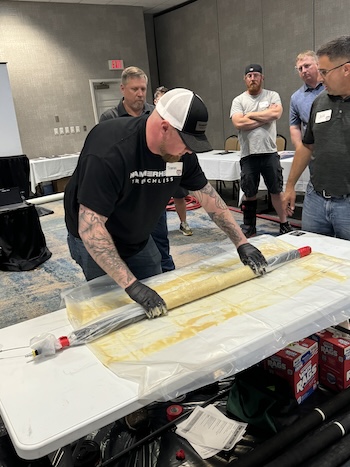
Thomas Davies prepares the standard packer wrapped in a resin-coated fiberglass sheath.
Next, the group ventured outside to watch the lateral clay pipe bursting demo— initiated by Nate Hrabosky, regional sales manager and assisted by Davies—using HammerHead’s PortaBurst PB30 machine. The rugged PortaBurst system replaces 2 to 6″ lateral pipes with up to 30-tons of pulling force.
And saving perhaps the best for last, attendees get to see Hammerhead’s proprietary BlueLight LED CIPP lining system in full effect. The Bluelight LED CIPP lining system for laterals and small drain pipes is the most advanced light-curing system available. The LED light head up to five times faster than other methods. The specially formulated resin only cures under light in the “blue” wavelength, giving installers a significantly longer working time between liner wet-out and curing. Once installed, the automated curing system pulls the LED light head through the liner, curing the resin almost instantly—up to five times faster than other methods. Instead of waiting hours for the liner to cure, a 50-foot sewer line could be fully cured in under 10 minutes.

Nate Hrabosky readies the PortaBurst PB30 machine for a clay pipe bursting demo.
In fact, contractor friend Diego Lujan, president, Alphalete Plumbing Drain & Sewer Rehab (@alphalete_plumbing_drain_sewer), Colorado Springs, Colo., gives high marks for the Bluelight CIPP system. “At Alphalete Plumbing, we absolutely love using the HammerHead Translucent Blue Light CIPP Liner Cure Machine. It’s been a complete game-changer for us,” says Lujan.
“The speed and efficiency this machine delivers are unparalleled, making pipeline repairs easier, more reliable, and environmentally friendly. We can’t imagine using anything else—it’s forever our go-to for trenchless technology.”
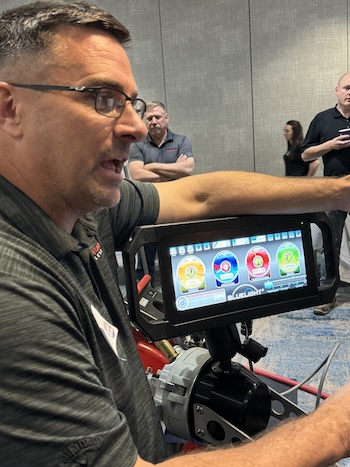
Urbanski discusses BlueLight’s diagnostics and intuitive touchscreen interface, which is easy to learn and operate. Simply input the job specs and the system will automatically set pull-back speed.
The Road Tour is a great way to get up close and personal with HammerHead products. Nonetheless, the team is equally as excited to get on job sites across the country as well. “We love being on job sites, and we love solving problems,” says Urbanski.
Be sure to check out HammerHead on the road.
Remaining HammerHead Road Tour
• Raleigh, N.C. — July 16
• Des Moines, Iowa — July 23
• Salt Lake City — August 27
• Lake Mills, Wis. — More info coming soon!
